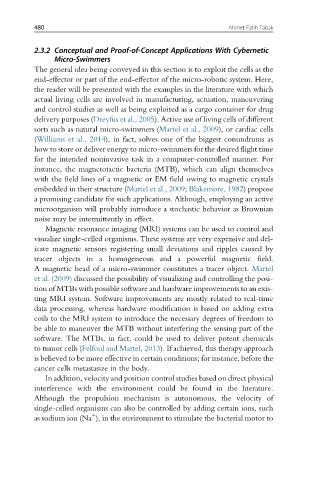Page 486 - Handbook of Biomechatronics
P. 486
480 Ahmet Fatih Tabak
2.3.2 Conceptual and Proof-of-Concept Applications With Cybernetic
Micro-Swimmers
The general idea being conveyed in this section is to exploit the cells as the
end-effector or part of the end-effector of the micro-robotic system. Here,
the reader will be presented with the examples in the literature with which
actual living cells are involved in manufacturing, actuation, maneuvering
and control studies as well as being exploited as a cargo container for drug
delivery purposes (Dreyfus et al., 2005). Active use of living cells of different
sorts such as natural micro-swimmers (Martel et al., 2009), or cardiac cells
(Williams et al., 2014), in fact, solves one of the biggest conundrums as
how to store or deliver energy to micro-swimmers for the desired flight time
for the intended noninvasive task in a computer-controlled manner. For
instance, the magnetotactic bacteria (MTB), which can align themselves
with the field lines of a magnetic or EM field owing to magnetic crystals
embedded in their structure (Martel et al., 2009; Blakemore, 1982) propose
a promising candidate for such applications. Although, employing an active
microorganism will probably introduce a stochastic behavior as Brownian
noise may be intermittently in effect.
Magnetic resonance imaging (MRI) systems can be used to control and
visualize single-celled organisms. These systems are very expensive and del-
icate magnetic sensors registering small deviations and ripples caused by
tracer objects in a homogeneous and a powerful magnetic field.
A magnetic head of a micro-swimmer constitutes a tracer object. Martel
et al. (2009) discussed the possibility of visualizing and controlling the posi-
tion of MTBs with possible software and hardware improvements to an exis-
ting MRI system. Software improvements are mostly related to real-time
data processing, whereas hardware modification is based on adding extra
coils to the MRI system to introduce the necessary degrees of freedom to
be able to maneuver the MTB without interfering the sensing part of the
software. The MTBs, in fact, could be used to deliver potent chemicals
to tumor cells (Felfoul and Martel, 2013). If achieved, this therapy approach
is believed to be more effective in certain conditions; for instance, before the
cancer cells metastasize in the body.
In addition, velocity and position control studies based on direct physical
interference with the environment could be found in the literature.
Although the propulsion mechanism is autonomous, the velocity of
single-celled organisms can also be controlled by adding certain ions, such
+
as sodium ion (Na ), in the environment to stimulate the bacterial motor to

